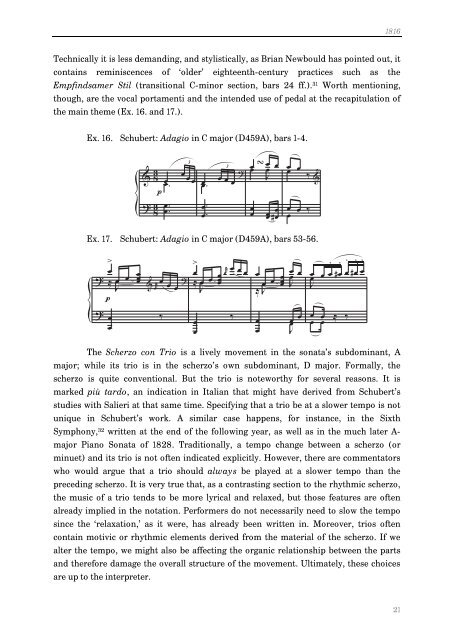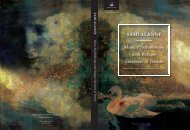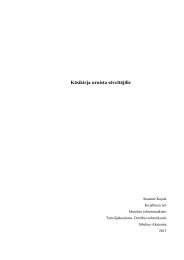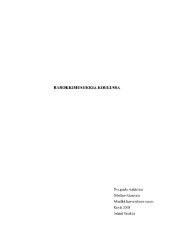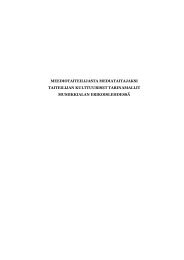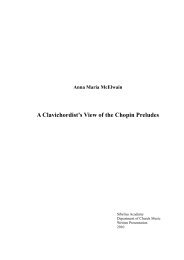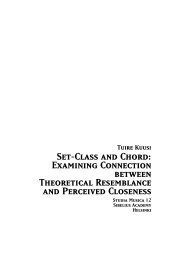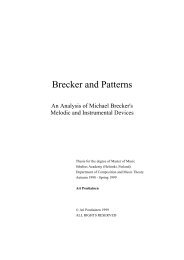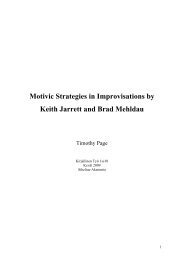The Unfinished Piano Sonatas of Franz Schubert Javier ... - Ethesis
The Unfinished Piano Sonatas of Franz Schubert Javier ... - Ethesis
The Unfinished Piano Sonatas of Franz Schubert Javier ... - Ethesis
You also want an ePaper? Increase the reach of your titles
YUMPU automatically turns print PDFs into web optimized ePapers that Google loves.
Technically it is less demanding, and stylistically, as Brian Newbould has pointed out, it<br />
1816<br />
contains reminiscences <strong>of</strong> ‘older’ eighteenth-century practices such as the<br />
Empfindsamer Stil (transitional C-minor section, bars 24 ff.). 31 Worth mentioning,<br />
though, are the vocal portamenti and the intended use <strong>of</strong> pedal at the recapitulation <strong>of</strong><br />
the main theme (Ex. 16. and 17.).<br />
Ex. 16. <strong>Schubert</strong>: Adagio in C major (D459A), bars 1-4.<br />
3<br />
& 8 œ .<br />
p<br />
? 3 œ .<br />
8 œ .<br />
3<br />
œ œ œ<br />
œ .<br />
œ .<br />
œ .<br />
3<br />
œ œ œ<br />
?<br />
œ T œ<br />
œ œ<br />
J<br />
œ œ œ # œ<br />
œ œ ‰<br />
œ<br />
œ œ ‰<br />
œ<br />
Ex. 17. <strong>Schubert</strong>: Adagio in C major (D459A), bars 53-56.<br />
?<br />
><br />
œ<br />
≈ œ<br />
J<br />
p<br />
œ œ r œ & œ œ œ<br />
? œ<br />
œ<br />
‰<br />
?<br />
><br />
œ<br />
≈ J œ œ œ<br />
œ<br />
œ<br />
r<br />
œ œ œ œ<br />
‰<br />
œ œ œ<br />
œ Jœ<br />
≈ J œ œ<br />
œ<br />
œ<br />
œ J<br />
œ<br />
&<br />
. . .<br />
œ œ œ # œ œ<br />
œ<br />
J<br />
œ œ ≈ ‰<br />
<strong>The</strong> Scherzo con Trio is a lively movement in the sonata’s subdominant, A<br />
major; while its trio is in the scherzo’s own subdominant, D major. Formally, the<br />
scherzo is quite conventional. But the trio is noteworthy for several reasons. It is<br />
marked più tardo, an indication in Italian that might have derived from <strong>Schubert</strong>’s<br />
studies with Salieri at that same time. Specifying that a trio be at a slower tempo is not<br />
unique in <strong>Schubert</strong>’s work. A similar case happens, for instance, in the Sixth<br />
Symphony, 32 written at the end <strong>of</strong> the following year, as well as in the much later Amajor<br />
<strong>Piano</strong> Sonata <strong>of</strong> 1828. Traditionally, a tempo change between a scherzo (or<br />
minuet) and its trio is not <strong>of</strong>ten indicated explicitly. However, there are commentators<br />
who would argue that a trio should always be played at a slower tempo than the<br />
preceding scherzo. It is very true that, as a contrasting section to the rhythmic scherzo,<br />
the music <strong>of</strong> a trio tends to be more lyrical and relaxed, but those features are <strong>of</strong>ten<br />
already implied in the notation. Performers do not necessarily need to slow the tempo<br />
since the ‘relaxation,’ as it were, has already been written in. Moreover, trios <strong>of</strong>ten<br />
contain motivic or rhythmic elements derived from the material <strong>of</strong> the scherzo. If we<br />
alter the tempo, we might also be affecting the organic relationship between the parts<br />
and therefore damage the overall structure <strong>of</strong> the movement. Ultimately, these choices<br />
are up to the interpreter.<br />
. .<br />
# œ œ<br />
21


